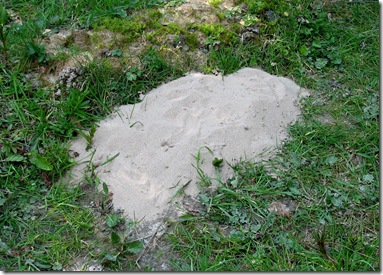22 April 2008. There is a flower on a third dandelion plant now.
There are many wrinkled ants running about on the Lyon Stone and they appear to be building an earth particle nest in front of it, something I have not observed them doing before.
24 April 2008. Everything is doing well as the season advances. Springwatch (BBC TV) rang up today and want to re-show last year's session at Emthree and take the window box to Bill Oddie's garden in London.
Spikes of sweet vernal grass are starting to appear and are moving towards anthesis very quickly. The red campion in Submespilus Assart South has one, two, three four open flowers.
I am still struggling with the male ferns (Dryopteris spp.) and need to do more work on distinguishing D. filix-mas from D. affinis - all the fern books seem very misleading.
There are several tiny, self-sown forget-me-nots in flower a short distance from the original plant and I wonder why they are so small compared with their parent: not fertilised by snail juice and bird poo washing over the edge of Butterfly Rock maybe.
25 April 2008. Every day Emthree gets greener and greener and more grassy looking.
I have rediscovered the fleabane plant, but its first leaves are quite a long way from where they were last year, having travelled to the north east of Onelitre Pond, whereas last year it grew to the south of this water body.
The third year bramble - primocane, floricane 1, floricane 2 - will flower soon, well ahead of last year's floricanes.
Midsummer Pond is full of mosquito larvae and the wrinkled ants are ferreting about on Lyon Rock again.
26 April 2008. A lovely spring day. The creeping buttercup on Submespilus Assart North has an opened flower and a dandelion, mirabile dictu, is blooming in a very shady spot on the north side of Medlar Wood demonstrating how at least some dandelion microspecies will grow successfully in low light conditions.
Ants were hustling about on Lyon Rock again, but as soon as I come on the scene they disappear. They are definitely interested in the fox's poo, but just clamber about on it like mountaineers rather than searching for something to eat.
The red campion in The Waste is sending up what looks very much like a flowering stem. There seem to be two forms of this plant: one that is fairly bushy and another, often paler green, that sends up solitary, upright flowering shoots.
I think my tiny, rabbit-bitten holly seedling in The Waste going to survive as it has produced some tiny, toffee-green blimps, new buds near the shoot tip.
28 April 2008. I am beginning to believe we have only one scaly male firm, at the western end of Medlar Wood. The other three have much less of a golden cast as they unfrond and are probably Dryopteris filix-mas. But if so the books are wildly wrong.
I pinched off one of the shoot tips of the perforate St John's wort today as the plant is supposed to contain red juice called, in Germany, Balder's blood. It does not have red juice, only the normal, greenish sap. However, I did find a larva of the St John's wort beetle Chrysolina hyperici on top of one of the shoots, so the species has overwintered successfully (I found one adult beetle in Emthree last May).
There is a young plant in Great Plantain Desert which looks like hoary willowherb (Epilobium parviflorum) while halfway along North Wall in Mice & Red there are a couple of leaves that look like betony (Stachys officinalis), which would be quite a turn up (but it might be leggy ragwort).
The rabbit-bitten holly in The Waste is unquestionably producing new leaves. I am very pleased about this as I thought I had lost it.


